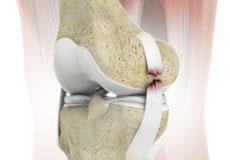
The knee is the most complex joint in the body formed by the articulation between the thigh bone (femur) and the shinbone (tibia). These bones are held together by four strong ropes like structures called ligaments. The knee has four major ligaments – the anterior cruciate ligament, posterior cruciate ligament, lateral collateral ligament, and medial collateral ligament. Two collateral ligaments are present on the sides of the knee and control the sideways movement of the knee. The anterior and posterior cruciate ligaments which are present in the centre of the knee joint control the back-and-forth movement of the knee.
Ligament knee injuries are common in athletes involved in contact sports such as soccer, football and basketball. Ligament injuries occur as a result of major trauma such as a direct blow to the knee, or a fall from a height, or motor vehicle trauma. Patients with ligament knee injuries may experience pain, swelling, limited range of motion, injuries to nerves and arteries of the leg, and knee instability.
Knee ligament injuries are graded based on the severity of injury. In grade I the ligament is mildly damaged and slightly stretched, but the knee joint is stable. In grade II there is a partial tear of the ligament. In grade III there is a complete tear of the ligament and the ligament is divided into two halves making the knee joint unstable.
Most ligament knee injuries require surgery to reconstruct the ligaments. Reconstruction of the torn ligaments using a tissue graft taken from another part of the body, or from a donor is known as ligament reconstruction. The damaged ligament is replaced by the graft and fixed to the femur and tibia using metallic screws. Gradually, over a period of a few months, the graft heals.
Surgical reconstruction is usually performed arthroscopically. Arthroscopic reconstruction of the knee ligament is a minimally invasive surgery performed through a few tiny incisions. An arthroscope is inserted into the knee joint through one of the small incisions to provide clear images of the surgical area (inside the knee) to the surgeon on a television monitor. Guided by these images the surgeon performs the surgery using small surgical instruments inserted through the other small incisions around the knee. As the surgery is performed through small incisions it provides the following benefits:
- Less post-operative pain
- Shorter hospital stay
- Quicker recovery.
Following arthroscopic reconstruction of the injured ligament most athletes are able to return to their high-level sport after a period of rehabilitation.





